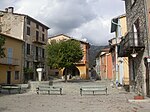The Mercantour-Argentera massif (French: Massif du Mercantour-Argentera, Italian: Massiccio del Mercantour-Argentera) is a massif in the Maritime Alps located astride the French departments of Alpes-Maritimes and Alpes-de-Haute-Provence and the Italian region of Piedmont. The name of the massif comes respectively from the summit of Mercantour, a secondary central summit, and from Mount Argentera, the highest point of the massif (3,297 m (10,817 ft)), entirely in Italy.
The massif is partially covered by two natural parks, the Mercantour national park on the French side and the Maritime Alps natural park on the Italian side. These parks are important because they protect many rare animal and plant species, like Speleomantes strinatii and Saxifraga florulenta, which is only found in this massif and used to be a symbol of the Mercantour Park. The massif is also full of rivers and lakes, most of which were formed during the last Ice Age and are found in the basins of the massif’s crystalline rocks.
This area has been home to humans since the Early Bronze Age, with signs of this early occupation particularly visible at Vallée des Merveilles. Human presence in the area grew during Antiquity and the Middle Ages, notably with the establishment of the salt route. In the 20th and 21st centuries, the massif has become a popular destination for tourism and recreation. The area offers a range of outdoor activities and sports, including ski touring, alpine skiing, cross-country skiing, hiking, mountaineering, and canyoning. Today, the economy of the massif is primarily focused on the tourism sector, which has largely overtaken agricultural and industrial activities.
The massif is associated with an important cultural heritage, which inspires artists as evident in its representations and appearances in painting, cinema, music and literature.











